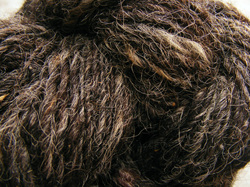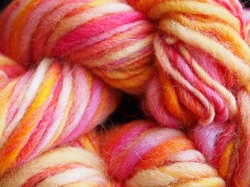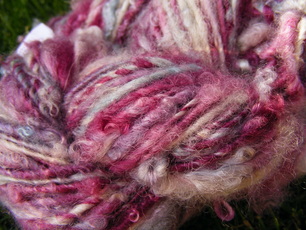It's a gloomy trying to rain day in Wyoming and I've been dyeing Lincoln wool and a superwash Columbia Rambouillet wool roving. I've been doing this for years and the process is pretty automatic to me. Clean wool, stuff in canning jars, make dye, add dye, heat set, let cool, dry, spin. Today I looked at the curly Lincoln wool and squished roviing in the jars and noticed something- the play of color and texture is actually very intriguing. So much, that I took the pictures you see below. Maybe I should pay attention more often.
 We need to start here, specifically how a Spaniard sheep got to New Mexico: Navajo churro sheep are descendants of the Iberian Churra sheep, brought to the Rio Grande Valley (i.e. New Mexico) in 1598 as Spain was establishing villages in this new area (at least to them). The initial number brought with Don Juan Onate and his settlers was 2900 sheep. The Spanish enslaved the Pueblo people and had them work as shepherds and weavers, the Navajo acquired sheep through trade and raiding. In 1680, the Pueblo people revolted and threw out the Spanish, but they didn’t take their sheep. The Navajo acquired more sheep and expanded the flocks for food, but more importantly for this story, for their wool. These sheep remained in isolated flocks throughout the area that would become New Mexico and Arizona with the Navajo and Pueblo peoples. In an attempt to get Navajo lands for Western settlers, the US government ordered the destruction of Navajo orchards, but also their sheep. This military action culminated with the Navajo Long Walk, where they were forced to march 300 miles to Bosque Redondo, New Mexico. As with the Cherokee Trail of Tears, many didn’t make it. After 3 years, the Navajo were allowed to return to their ancestral land and families were issued “native sheep” from flocks that were from New Mexican villages. The last hurdle the sheep and the Navajo had to endure was a 1930s program to eradicate some of the livestock on the Navajo reservation due to a severe drought. By this time the flock which had grown to over ½ million was reduced by about 30%. The Navajo said they knew how to manage their stock of sheep, goats, and horses on their land as they had for hundreds of years and this was unnecessary. By the 1970s, the Navajo Churro was critically endangered at around 500 head. Several conservancies stepped in and slowly the sheep breed has been revitalized, although still in low numbers compared to many other sheep breeds, but it is no longer facing extinction. Churro sheep are double coated, with a long straight coarse top coat and a softer, shorter inner coat. The staple length is 6-12 inches for the outer coat, and 3-5 for the inner coat. Many have horns, some with four or more. They are well suited to the harsh environment of the desert Southwest of cold night, hot days, and little water. They come is all colors of brown, black, white, and pretty much any color in between. It’s supposed to be a no- luster wool but I have seen a few fleeces with a pearlescent sheen to them. I’ve got my hands on several fleeces and mini mill produced roving over the past years. All but one have been from New Mexico, the stray one was from a farm in Montana. Most have been dark brown, grays, and black. I’ve also spun some oatmeal color roving before. I also have one gorgeous white fleece I’m hanging onto for a spinning/natural dyeing project. I’ve got fleeces with really coarse outercoats and some where the outercoat was almost as fine as the innercoat. I don’t separate the coats, I just fluff and spin, however I’ve found that is the outercoat is really coarse it is actually easier to separate the two. You hold each end of the fleece and pull apart. In general, Navajo churro is not next to skin soft. Lamb fleeces are the exception. However, you need to remember the breed’s wool was used for weaving hardwearing objects such as saddle blankets and rugs, which the wool’s coarseness is perfectly suited for. Below is some of my Navajo churro handspun yarns. All but one are natural colored. I was spinning some handdyed Wensleydale wool roving last night. Below is some pics of the yarn in progress. It is a self-striping yarn. The roving had blocks of color so instead of slivering the wool, I pulled out chunks by color. It's turned out to be a very bright colored and fun yarn! That's my Ashford Kiwi 2 spinning wheel that I'm using.  So when you hear the word Shetland do you think of small ponies and dogs that look like mini-Collies? Windswept islands? Lace? I think of lace first (because I love knitting lace) and then I think of sheep. Like the miniaturized version of horses and dogs that inhabit the Shetland Islands, the sheep are also smaller too, topping out at 125 pounds. For comparison, my friend’s St. Bernard dog weighs more at 140 pounds. The breed is old, and retains many other historical characteristics besides size, most notably color. Where many sheep breeds have been bred to be large flocks of white to be sold to the textile industry, Shetland sheep still come in a rainbow of earthy colors- from creams, browns, grays, blacks, and all color in-between. Traditional names like emsket, shaela, mioget, and moorit are still regularly used. Shetland sheep came in single or double coat, or a wavy coat. It is soft. Staple length of the fleeces I have spun have ranged from 3-7 inches long. Below is some pictures of fleeces I have worked with throughout the years and I never have got a coarse fleece. I’ve also worked with all three types- I don’t prefer one over another. I don’t separate the double coat fleece, I just combine the two either just by fluffing by hand or carding, and spin. You can also get Shetland roving in several colors from a variety of sellers such as the Woolery, Paradise Fibers, and Bountiful Spin and Weave. Roving is prepared fibers. It is combed into a ropelike.. well.. rope and ready to spin. I find it easier to spin if I separate the rope into several strips, about ½ inch wide. The roving comes in brown, gray, and white. I love spinning Shetland wool, hence the “Favorite Fibers” title. I love the range of colors and it is always reliably soft. I mentioned above where I get roving. I have got fleeces from sellers on Ebay and Etsy. There are also farms whose info is in the classifieds section of Spin Off Magazine. I have an oatmeal Shetland fleece that I am washing right now and will be spinning soon, so update to come! Below is a sampling of the Shetland handspun yarns I have created through the years.  I love natural color wool. Shades of gray, brown, tan, cream- I love them all. I seek out colored fleeces and when I can find a good one…well... let’s say the stash is large. In the last month I have added an oatmeal color Shetland fleece and a charcoal gray Coopworth fleece. It’s probably true that if not for handspinners, all sheep would be white. White wool is extensively used in the textile industry because you dye it a rainbow of colors reliably from batch to batch. But even the most numerous sheep in the world, the merino, can come in shades of brown and gray. So let’s honor those lovely fleeces that give us a wonderful range of earthy colors. P.S. I included white in the pics below- it’s a lovely natural color after all. P.P.S. Yes, these are all my handspun yarns.  So exactly how many pounds of Border Leicester have I spun? I lost count years ago, but a guesstimate it’s around 500 pounds. Yes, I love Border Leicester… now. But it wasn’t always this way. In sheep longwool, I started out with Cotswold wool. Then the farm I purchased my wool from sold their flock. Cotswolds are rare in the US and the fleece is hard to find to start with, and demands a high price per pound. So to Ebay I went. I buy fleeces from Ebay from time to time. I’ve found some wonderful farms with beautiful wool, and know which sellers to stay away from now because of less than spinning quality wool. As an aside, Etsy also has some great farm sellers, as does the website Local Harvest. But anyway, it was because of Ebay that I found the farm in Tennessee that is one of my staple farms I purchase raw wool from. Of that aforementioned 500 pounds, at least 300 is theirs.  Border Leicester is an English wool breed resulting from crossing English Leicester rams with Teeswater ewes. The breed was supposedly brought to America by George Washington who kept a few at Mount Vernon. Like most longwool sheep, the breed was on the decline during the 20th century until handspinners found the charm and uniqueness of the wool. It is also a good lamb sheep breed, which also saved it from further decline. Enough of the history lesson. Border Leicester wool is medium to high luster, with wide crimp. I’ve found fleeces in white, as well as shades of brown. Staple length of fleeces that have grown for a year range from 5 to 10 inches. Many farms shear twice a year. It is low grease which makes washing easy. Most of the wool I have found is medium to very soft. Lamb fleeces are very soft, and have a tighter crimp. One lamb fleece had curly ends. I love spinning the wool and do minimal preparation to keep the crimpy quality of it. All I do is sit in front of the TV and fluff wool locks and spin the slightly opened fleece. I have two wheels, and prefer my Louet S17 for my fleecespun yarns. The bobbin lead system of this wheel versus the flyer lead system on my Ashford Kiwi pulls the yarn onto the bobbin quicker and leads to less chance of overspinning. I would love to say something poetic about the wool at this point but I will let the pictures of my handspun yarn do the talking. |
AuthorYarn artisan, Spinning Gypsy, lover of all sorts of textile arts Archives
September 2014
Categories
All
|


 RSS Feed
RSS Feed
